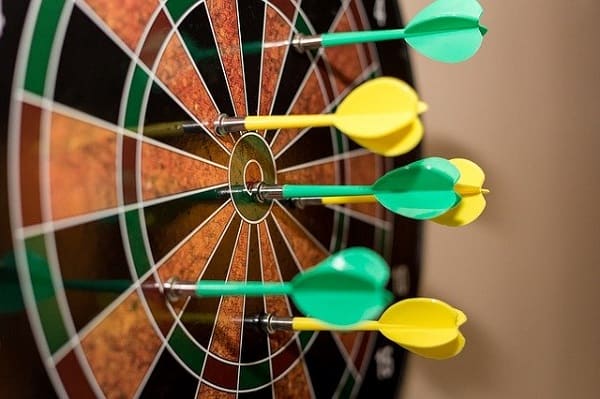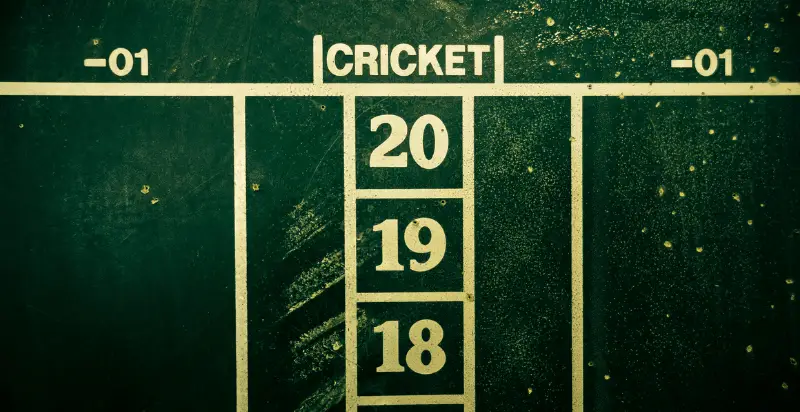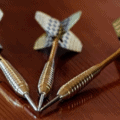Playing darts is fun, but do you know what’s also exponentially cool - cricket darts! Cricket darts is a popular way to play darts in America. It has a bunch of strings, including that the rules are very simple and the game gives beginners more of a chance against stronger players.
The aim is ultimately to close numbers 15 through 20 and the bulls eye by hitting the opponent.
Sound like fun? Well, here is the lowdown on the basic rules of how to play cricket darts so you can wow your opponents next time you hit the bar and there’s a dartboard there.

Equipment Needed
You don’t need much to play cricket darts. To start with, you’re going to need at least three darts. You can also get more if you would rather not share. Of course, it goes without dsaying that you are going to need a dartboard. You will also need something that you can write the score down with. This could be a pen and paper, a chalkboard and chalk, or there are even cricket scoreboards that you can get on your phone.
How Many Players?
Usually you play cricket darts with two players or in teams of two. There isn’t really a specific set of tules on the amount of players that can play.
Objective
The main objective of the game of cricket darts is to have more points than the other team once the numbers 15 through 20, and the bullseye, have all been closed out. Whoever meets this criteria is the person or team that will win the game.
Game Rules
The game requires players to take turns throwing three darts at the dart board, and they need to hit 15 through 20 and the bullseye. If you end up hitting any other numbers, nothing is going to happen.
Cricket darts is going to require you to ‘close out’ numbers. What does this mean? Well, essentially players will have to score each number (as we’ve already said, that’s 15 through 20) and the bullseye three times before you can end the game.
If you end up hitting the outer ring of a number, that will count for two, and if you happen to hit the inner ring then that will count as three. That is, of course, unless you are aiming for the bullseye, in which case the outer ring will count of one and the inner circle will count for two. For instance, if you ended up hitting the inner ring of 15, then that will close it out for your team.
If a player ends up closing out a number before the other does, then that player will be able to begin racking up points each time they happen to hit that number until the other play ends up closing it out.
When both of the teams have closed out a number, it isn’t in play anymore and neither of the teams will be able to score points on it. Whichever team closes out the board with greater or equal points will win.
Scoring on a Cricket Dartboard
The scoreboard of a cricket dartboard is set up with a 3 column layout, with the dartboard numbers (15-20 and the bullseye) in the middle and these need to be closed out. As we’ve already said, none of the other numbers that are on the board actually count in this game, and they should be considered to be a miss if you hit them.
The suitable numbers and the bullseye are considered open until both of the teams have hit it three times. If one of the teams has managed to close out a number or the bullseye then it can be scored on until the opposing team also managed to close it out.
The single rings on the board will count as one hit, and when scoring they should be marked with a single slash (/). If you hit the double ring on the outside of the board then this is counted as two hits (marked X on the scoreboard) and then the triple ring counts as three hits (market O on the scoreboard). Then, the outer bullseye is counted as one and the inner bullseye is counted as two.
When one team manages to close out a number of the bullseye, every hit will give the team points in accordance to the number on the outside of the dartboard. The outer bullseye will count as 25 and the inner bullseye will count at 50.
Strategies for Playing Cricket Darts
If you’re playing cricket darts without points, the strategy can be pretty simple. All you need to do is close out all of the numbers before your opponent does. If you are going to be playing with points then the strategy you choose is largely going to depend on how your game is going.
One place to start is to attempt to close the 20s because this will give you the most points once they are closed out. If you are able to close out the 20s early on then it gives you some leverage as far as points are concerned early in the game.
A lot of players will tend to have numbers that will be easier for them to hit. If you are familiar with your opponent then it’s worth trying to close out the places they are likely to hit. This means that you won’t be leaving it open which could allow them to rack up points on you. If your opponent opts for a certain number, perhaps try hitting that number too. You need to be familiar with what your opponent is doing.
If you’re a beginner then it may be worth trying to hit the bullseye from the start. These can be tricky to hit no matter what your skill level, but if you can manage to get a lucky hit or two in it’s a simple way to give you a headstart, especially if you haven’t changed targets yet for defensive play.
Another strategy is to throw first and gain points. If you can throw first, it means you can get closest to the bullseye at the start of the game. It means you can close out a number and then start adding on points before your opponent even gets a strike in. Then, when they do take their first turn, they are essentially going to be playing catch up. You should be trying to keep a points margin through the game.
Try to be familiar with what’s comfortable for you too. If you have some numbers that are a little easier for you then try to close these first and build a buffer then with points.
For instance, a lot of players will start with 20, but the majority of games aren’t really played in sequence. If you’re more comfortable twitch the bottom numbers then aim for those to start with in order to make some room and then give yourself a little bit more time on the numbers that generally cause you issues.
Different Variations on Cricket Darts
There are a couple of cricket dart variations that can switch up the game, making things easier, harder or to speed things up.
Playing Without Points
If you are playing without points, every player just closes out the numbers without needing to worry about scoring points. This is a great way to do it if you have people waiting to play, or if you want to keep things lighthearted among your friends.
This is a great way to play if you’re in a bar atmosphere that’s a little more relaxed and it’s a good way to play if you’re a beginner.
Playing in Order
One way to make the game more challenging is by only counting the numbers that are thrown in sequence, beginning at the 20 and then counting down to the bullseye. This means that any points that are made out of order do not count.
Adding More Numbers
If you want to make the game longer then you can add to the numbers that are in play. For instance, after the 15 you can add the numbers 14 through to 11 before the bullseye. This will make the game longer and it can add the challenge of adding more areas on the board.
Cutthroat Cricket
This is also known as 3 way Cricket, and it’s essentially the normal game with three players instead of two. This can make scoring a little bit more tactical because two players can team up and rake in some points in order to eliminate other players.
Conclusion
So there you have it - That’s how you play cricket darts! Cricket darts can be a fun way to pass the time while you’re hanging out with friends in a bar or it can be played competitively for stakes. Either way, we hope that we’ve given you a little bit of insight on how to play this fun game of darts!
Finally, read more about other fun dart games and learn the proper height and distance for your dartboard.

I’m Lia and I love playing games. I started this site to share things with friends and they encouraged me to post more and now I’m trying to share things with the world – indoor and outdoor sports, and board and bar games. I write about things like Bocce, Croquet, Billiards, Darts and other fun ways to enjoy time with your friends and family!







